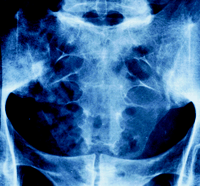This week in the BMJ
Volume 333,
Number 7568,
Issue of 16 Sep 2006
![[Down]](/icons/down.gif) How to manage ankylosing spondylitis
How to manage ankylosing spondylitis
![[Down]](/icons/down.gif) Use long needles to immunise infants
Use long needles to immunise infants
![[Down]](/icons/down.gif) Severity of acute illness predicts post-infective fatigue syndrome
Severity of acute illness predicts post-infective fatigue syndrome
![[Down]](/icons/down.gif) Palpation is poor at spotting non-cephalic presentation
Palpation is poor at spotting non-cephalic presentation
![[Down]](/icons/down.gif) Plagiarists should be publicly exposed
Plagiarists should be publicly exposed
How to manage ankylosing spondylitis
Early diagnosis of ankylosing spondylitis can be difficult but is important for its treatment, say McVeigh and Cairns (p 581). This clinical review discusses how this chronic inflammatory rheumatic disorder, which primarily affects the axial skeleton, is diagnosed using history, examination, genetics, laboratory findings, and imaging. The authors describe traditional treatment, which begins with physiotherapy and non-steroidal anti-inflammatory drugs. They also outline why and how tumour necrosis factor inhibitors have revolutionised the treatment of ankylosing spondylitis—and the problems associated with this approach.

|
Credit: ST BARTHOLOMEW'S HOSPITAL/SPL
|
|
![[To top]](/icons/back.gif)
Use long needles to immunise infants
Long (25 mm) needles are best for immunising children aged 2, 3, and 4 months, say Diggle and Deeks (p 571). They randomised almost 700 healthy infants who had been vaccinated with a combined diphtheria, pertussis, tetanus, and Haemophilus influenzae type b vaccine and a meningococcal C vaccine at ages 2, 3, and 4 months to either a long wide needle (25 mm, 23 gauge), a short narrow needle (16 mm, 25 gauge), or a long narrow needle (25 mm, 25 gauge). Long needles significantly decreased local reactions after each dose, and immunogenicity was comparable between long and short needles, independent of the width.

|
Credit: IAN HOOTON/SPL
|
|
![[To top]](/icons/back.gif)
Severity of acute illness predicts post-infective fatigue syndrome
The severity of acute illness is a key risk factor for post-infective fatigue syndrome, rather than sex, age, or psychological factors. The syndrome represents a stereotyped outcome from several viral and non-viral infections. Hickie and colleagues (p 575) followed more than 250 patients with Epstein-Barr virus, Coxiella burnetii, or Ross River virus at regular intervals in a year from the time of acute infection, using self report, structured interview, and clinical assessment. A relatively uniform post-infective fatigue syndrome persisted for six months or more in a significant minority of patients.
![[To top]](/icons/back.gif)
Palpation is poor at spotting non-cephalic presentation
Clinical examination with palpation is not sensitive enough for the detection and timely management of non-cephalic presentation in late pregnancy. In a cross sectional analytical study, Nassar and colleagues (p 578) compared clinical examination with the standard of ultrasonography in more than 1600 women with a singleton pregnancy between 35 and 37 weeks' gestation attending antenatal clinics. Ultrasound identified non-cephalic presentation in 8% of women. Palpation had a sensitivity of 79% and a specificity of 95%. The positive and negative predictive value were 55% and 97%.

|
Credit: DEEPLIGHT PRODS/SPL
|
|
![[To top]](/icons/back.gif)
Plagiarists should be publicly exposed
Plagiarism is difficult to detect, especially if it occurs in journals with a small readership. Systematic reviews can help to identify cases, but, unless perpetrators face greater sanctions the problem is unlikely to go away, says Chalmers (p 594). He explains how he identified a case of plagiarism and tried to seek explanation. He was told to handle the misconduct tactfully, but further evidence showed that the author continued to plagiarise. Chalmers concludes that journals and institutions should take allegations of plagiarism more seriously and very publicly expose authors found guilty.
![[To top]](/icons/back.gif)
How to manage ankylosing spondylitis
Use long needles to immunise infants
Severity of acute illness predicts post-infective fatigue syndrome
Palpation is poor at spotting non-cephalic presentation
Plagiarists should be publicly exposed


